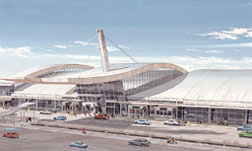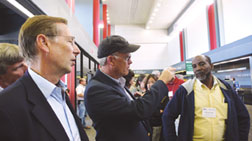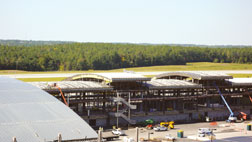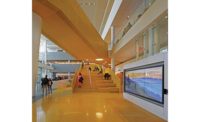Raleigh-Durham International Airport’s new Terminal C, under construction, will ride the first wave of a developing trend in airports: end-to-end, common-use terminal facilities.
 RDU Airport Authority
North Carolina terminal designed for flexibility.
|
“We’re building the system so that when IATA does ratify the standard, we only need to make minor changes,” says Mark Posner, Raleigh-Durham Airport Authority (RDU) deputy director. The new terminal will already have centralized communication and cabling rooms and airport-run terminal facilities. RDU will also provide and operate all technology functions in the terminal, including wireless Internet, cable TV and phones. “Our take is that the airlines should focus on flying airplanes,” says Cal Edmondson, RDU senior program manager.
 Aileen Cho
RDU’s Edmonson (left) says the agency wanted terminal to meet future common-use standards.
|
These considerations, plus the varied past of Terminal C as both hub and non-hub, prompted the authority to require maximum flexibility for the new terminal. “We wanted something flexible for the future—hold rooms designed to accommodate a number of aircraft, not specif-ically for any one carrier,” says David Powell, RDU director of major capital improvements. That includes column-free space and fitting 32 gates for a range of aircraft sizes.
 Aileen Cho
|
Archer Western Ltd., Atlanta, has a $362-million general contract to build the 920,000-sq-ft terminal in two phases. The first 600,000 sq ft will open next year and the rest in 2010. The 2,150-ft-long building includes roof heights of 48 ft for the concourse and 64 ft for the ticketing and checkpoint areas, says Charles McCloskey, program manager for Parsons Corp., RDU’s program manager. The checkpoint area will have 10 lanes. Roof trusses are a combination of steel and red-laminated wood as part of the design by Fentress Bradburn Architects, Denver. Prefabricated glass curtain-wall panels, 6 ft x 9 ft each, will be installed this month.
RDU also utilized a process dubbed “project definition.”Typically, the planning concept goes to a designer, who negotiates scope and fee and starts developing greater detailed concepts, notes Kevin Karl, principal consultant with Jacobs Consultancy, Burlingame, Calif. “Not until you’re well into schematics do you get reliable cost estimates,” he says.
But project definition gives the owner a stronger idea of cost, schedule and project vision before committing to a design. For Terminal C, RDU and Jacobs recruited a senior-level cast from engineering, design and specialty firms—who still had to compete for actual contracts for “sketching” workshops. Based on the resulting documents, cost estimates were made at 30%, 60% and 90% levels.
The $620-million terminal will be ready for a new standard, Common Use Passenger Processing Systems, if and when it is adopted by the International Air Transport Association. Airlines, once resistant, have bought in. “Economics are different,” says Powell. “When [airlines] were really convinced that we would do this, and we invited them to review our RFPs and vendors, some said, ‘We’d better take advantage of that.’” “It gives us a clear idea rather than getting led around by the architect to say, ‘Sure, I’ll take one of those and one of those,’” says Powell.


Post a comment to this article
Report Abusive Comment